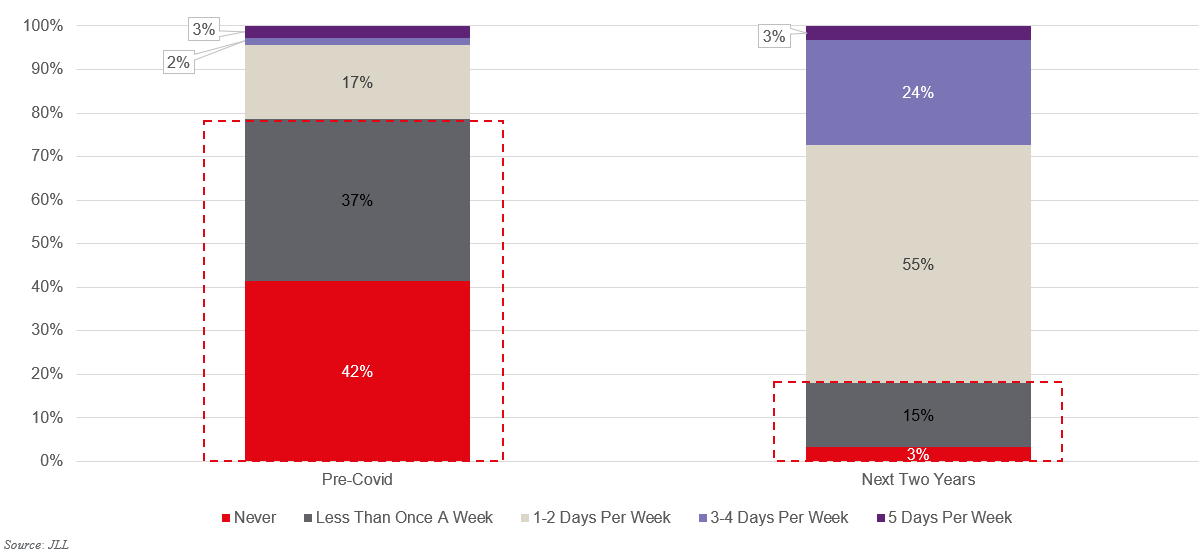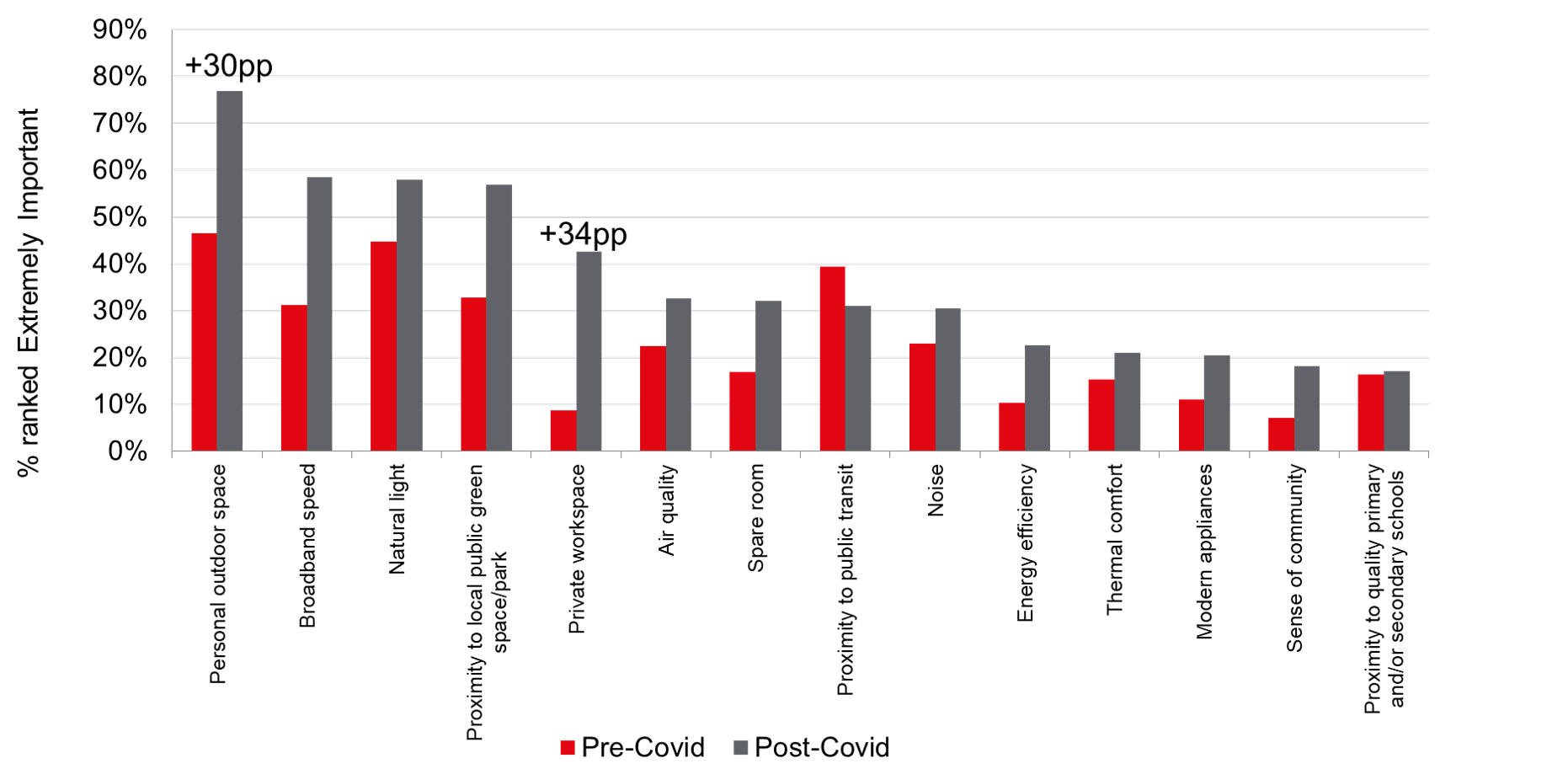Has lockdown changed our living priorities? We undertook a survey to assess whether this extended period spent at home due to Covid-19 has altered the way we feel about our homes.
Over the past few months more than half of the world’s population have been confined to their homes to combat the spread of Covid-19. The longer the confinement has gone on, the more people have been able to reflect on what they like and dislike about their homes. But has this extended period of time at home changed our living priorities?
We undertook a survey of our staff to assess this. There were more than 1,300 respondents to the JLL Living Survey at the time of writing, including just under 200 in the UK. Respondents in the UK range in age from 20 to 65 and live right across the UK.
Analysing the results of our UK respondents, our survey reveals two significant findings about the relationship between our staff and their homes.
1) There is a dramatic shift in our staff’s appetite to work from home more in the future
2) There has been an increase in the number of staff saying they now want to move home and their most important housing priorities have shifted – private outside space, faster broadband and a private home working area have significantly risen in importance.
Working from home
Covid-19 has triggered a widespread temporary shift to homeworking. The below graph shows how often the respondents to our survey worked from home in the past and, crucially, how often they would now like to work from home in the future. Pre-Covid-19, 79% of survey respondents worked from home less than once per week, and only 2% worked from home 3-4 days per week. Now only 18% of employees would hope to work from home less than once per week and 24% would like to work from home 3-4 days.
Working from home: the new normal?
Precovid-19, 79% of survey respondents worked from home less than once per week. Only 18% expect to do so over the next two years

If we were to assume that the wider population shares the same appetite as our staff, what does this mean for the future of the office? Crucially, just 3% of respondents said they would like to work from home full time – the same percentage as pre-Covid. This would indicate that the vast majority of us still want access to an office. But the role of those offices might change. As JLL UK CEO Chris Ireland predicted in a recent interview with Bloomberg, offices could become ‘ideas factories’ where we meet to be collaborative and creative. Humans are by nature social animals and numerous behavioural science studies have demonstrated that cooperation allows us to thrive.
Productivity
But alongside this whether we may want to work from home more in the future, perhaps the more significant question is whether we can actually be productive. Understanding productivity – what does it mean and how do we now measure it – has become a key focus for many businesses. Covid-19 is providing an unprecedented test case for home working, and the results in coming months of how businesses have performed will provide a huge evidence base to analyse productivity. In the past, numerous studies into productivity have shown that, in all likelihood, if an employee is productive in the office they are likely to be productive at home and vice versa. There are fundamental management issues when it comes to looking after a remote team, but there are some compelling environmental and social benefits that businesses may find hard to ignore.
Removing millions of commuters per week from the UK’s roads and transport networks should significantly reduce the nation’s carbon emissions. And there is evidence that working from home can be good for our well-being too. JLL’s Manchester office has been tracking the health and well being of our staff based in the city over the past few months. Our staff have recorded an average increase of a full nights extra sleep per month, along with improved sleep quality since working from home. Furthermore, our staff have seen a 6% improvement in their cognitive performance.
Moving home and changing priorities
Pre-Covid-19, 22% of our respondents were looking to move. However, that number has now increased to 45%. Of those looking to move, 42% would like to move away from an urban area; 1% would like to move towards an urban area and 57% would move within a similar area to their current home.
There is much debate around whether Covid-19 will spark a rush in demand from people now wanting to move home. Indeed Zoopla reported recently that buyer demand across England increased by 88% after the housing market reopened, exceeding pre-lockdown levels. And Rightmove recorded its busiest day ever since it launched in 2000 on Wednesday 27th May with more than six million visits to its website, 18% up on the same day last year.
Our survey does appear to indicate that what we consider to be important in our homes may be changing. We asked respondents to rank 14 metrics based on importance pre and post Covid-19. The biggest shifts in priorities ranked extremely important were having a personal outdoor space, fast broadband speed and a private workspace.
Living priorities have changed in light of Covid-19
Largest shifts seen across private workspace, personal outdoor space and broadband speed compared with pre-Covid sentiment

Temporary or permanent?
Will the shifts identified by our survey ultimately prove to be temporary or permanent? Some of the results in this survey may well have been skewed by the fact that respondents were answering while they were still in the ‘eye of the storm’. For this reason we will continue to revisit this survey in the coming months to see whether people truly have shifted their housing needs, or whether their current attitudes will begin to fade as they return to ‘normal’ life.

Kimberly Markiewicz – Senior Research Analyst - UK Living Research




